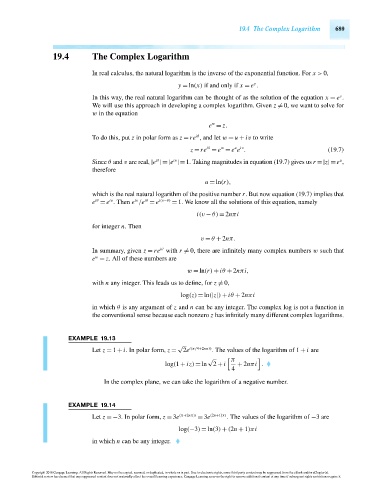Page 709 - Advanced_Engineering_Mathematics o'neil
P. 709
19.4 The Complex Logarithm 689
19.4 The Complex Logarithm
In real calculus, the natural logarithm is the inverse of the exponential function. For x > 0,
y
y = ln(x) if and only if x = e .
y
In this way, the real natural logarithm can be thought of as the solution of the equation x = e .
We will use this approach in developing a complex logarithm. Given z = 0, we want to solve for
w in the equation
w
e = z.
iθ
To do this, put z in polar form as z =re , and let w = u + iv to write
iθ
w
u iv
z =re = e = e e . (19.7)
iv
iθ
u
Since θ and v are real, |e |=|e |=1. Taking magnitudes in equation (19.7) gives us r =|z|=e ,
therefore
u = ln(r),
which is the real natural logarithm of the positive number r. But now equation (19.7) implies that
iv
iv
iθ
iθ
e = e . Then e /e = e i(v−θ) = 1. We know all the solutions of this equation, namely
i(v − θ) = 2nπi
for integer n. Then
v = θ + 2nπ.
iθ
In summary, given z = re with r = 0, there are infinitely many complex numbers w such that
w
e = z. All of these numbers are
w = ln(r) + iθ + 2nπi,
with n any integer. This leads us to define, for z = 0,
log(z) = ln(|z|) + iθ + 2nπi
in which θ is any argument of z and n can be any integer. The complex log is not a function in
the conventional sense because each nonzero z has infinitely many different complex logarithms.
EXAMPLE 19.13
√
Let z = 1 + i. In polar form, z = 2e i(π/4+2nπi) . The values of the logarithm of 1 + i are
√ π
log(1 + iz) = ln 2 + i + 2nπi .
4
In the complex plane, we can take the logarithm of a negative number.
EXAMPLE 19.14
Let z =−3. In polar form, z = 3e (π+2nπ)i = 3e (2n+1)πi . The values of the logarithm of −3are
log(−3) = ln(3) + (2n + 1)πi
in which n can be any integer.
Copyright 2010 Cengage Learning. All Rights Reserved. May not be copied, scanned, or duplicated, in whole or in part. Due to electronic rights, some third party content may be suppressed from the eBook and/or eChapter(s).
Editorial review has deemed that any suppressed content does not materially affect the overall learning experience. Cengage Learning reserves the right to remove additional content at any time if subsequent rights restrictions require it.
October 15, 2010 18:5 THM/NEIL Page-689 27410_19_ch19_p667-694

